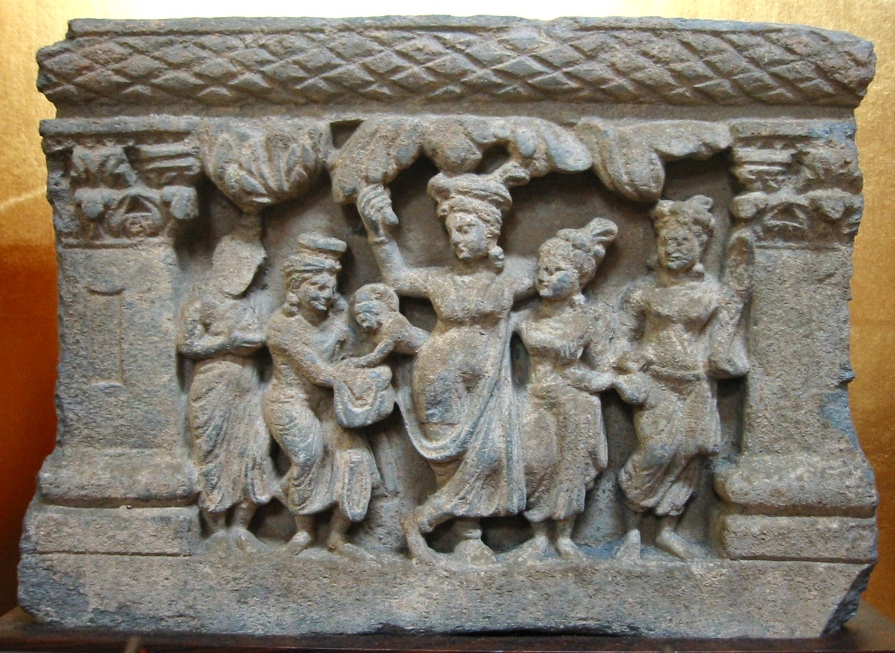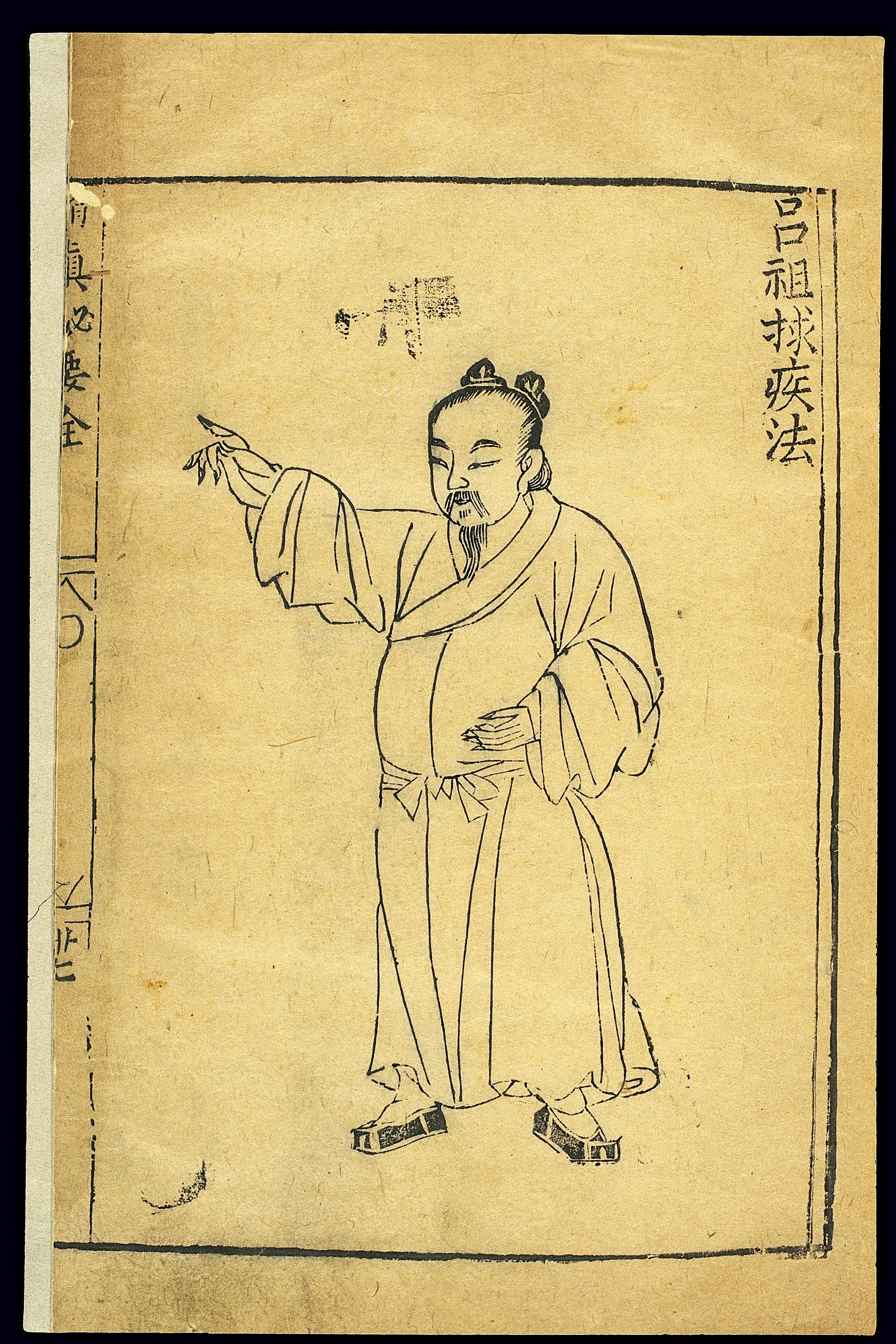|
Shengtai
(, "sacred embryo" or "embryo of sagehood") is a Chinese syncretic metaphor for achieving Buddhist liberation or Daoist transcendence. The circa fifth century CE Chinese Buddhist ''Humane King Sutra'' first recorded ("sagely womb") describing the bodhisattva path towards attaining Buddhahood; was related with the more familiar Indian Mahayana concept of ("embryo/womb of the Buddha", Chinese zh, p=rulaizang, c=如來藏) that all sentient beings are born with the Buddha-nature potential to become enlightened. The Chan Buddhist teaching master Mazu Daoyi (709-788) first mentioned post-enlightenment , and by the tenth century Chan monks were regularly described as recluses nurturing their sacred embryo in isolated locations. The renowned Daoist Zhang Boduan (984-1082) was first to use the expression ("sagely embryo") in a context of physiological Internal Alchemy, and adepts developed prolonged meditation techniques through which one can supposedly become pregnant, gestate, ... [...More Info...] [...Related Items...] OR: [Wikipedia] [Google] [Baidu] |
Neidan
Neidan, or internal alchemy (), is an array of esoteric doctrines and physical, mental, and spiritual practices that Taoist initiates use to prolong life and create an immortal spiritual body that would survive after death. Also known as Jindan ( "golden elixir"), inner alchemy combines theories derived from external alchemy ('' waidan'' ), correlative cosmology (including the Five Phases), the emblems of the ''Yijing'', and medical theory, with techniques of Taoist meditation, daoyin gymnastics, and sexual hygiene. In ''neidan'', the human body becomes a cauldron (or "ding") in which the Three Treasures of Jing ("Essence"), Qi ("Breath") and Shen ("Spirit") are cultivated for the purpose of improving physical, emotional and mental health, and ultimately returning to the primordial unity of the Tao, i.e., attaining Taoist Immortality. It is believed the '' Xiuzhen Tu'' is such a cultivation map. In China, it is an important form of practice for most schools of Taois ... [...More Info...] [...Related Items...] OR: [Wikipedia] [Google] [Baidu] |
Xingqi (circulating Breath)
( zh, c=, tr=circulating / breath) is a group of breath-control techniques that have been developed and practiced from the Warring States period (c. 475-221 BCE) to the present. Examples include Traditional Chinese medicine, Daoist meditation, breathing calisthenics, embryonic breathing, internal alchemy, internal exercises, deep-breathing exercises, and slow-motion martial art. Since the polysemous keyword can mean natural "breath; air" and/or alleged supernatural "Spirit (vital essence), vital breath; Energy (esotericism), life force", signifies "circulating breath" in meditational contexts or "activating vital breath" in medical contexts. Terminology is a linguistic Compound (linguistics), compound of two Chinese words: * has English Translation#Equivalence, translation equivalents of: # to march in order, as soldiers; walk forward ... # to move, proceed, act; perform(ance); actor, agent; follower ... # to engage in; to conduct; to effect, put into practice, imple ... [...More Info...] [...Related Items...] OR: [Wikipedia] [Google] [Baidu] |
Gautama Buddha
Siddhartha Gautama, most commonly referred to as the Buddha (),* * * was a śramaṇa, wandering ascetic and religious teacher who lived in South Asia during the 6th or 5th century BCE and founded Buddhism. According to Buddhist legends, he was born in Lumbini, in what is now Nepal, to royal parents of the Shakya clan, but Great Renunciation, renounced his Householder (Buddhism), home life to live as a wandering ascetic. After leading a life of mendicancy, asceticism, and meditation, he attained Nirvana (Buddhism), nirvana at Bodh Gaya, Bodh Gayā in what is now India. The Buddha then wandered through the lower Indo-Gangetic Plain, teaching and building a Sangha, monastic order. Buddhist tradition holds he died in Kushinagar and reached ''parinirvana'' ("final release from conditioned existence"). According to Buddhist tradition, the Buddha taught a Middle Way between sensual indulgence and severe asceticism, leading to Vimutti, freedom from Avidyā (Buddhism), ignora ... [...More Info...] [...Related Items...] OR: [Wikipedia] [Google] [Baidu] |
Pali
Pāli (, IAST: pāl̤i) is a Classical languages of India, classical Middle Indo-Aryan languages, Middle Indo-Aryan language of the Indian subcontinent. It is widely studied because it is the language of the Buddhist ''Pali Canon, Pāli Canon'' or ''Tripiṭaka, Tipiṭaka'' as well as the sacred language of ''Theravada, Theravāda'' Buddhism. Pali was designated as a Classical languages of India, classical language by the Government of India on 3 October 2024. Origin and development Etymology The word 'Pali' is used as a name for the language of the Theravada canon. The word seems to have its origins in commentarial traditions, wherein the (in the sense of the line of original text quoted) was distinguished from the commentary or vernacular translation that followed it in the manuscript. K. R. Norman suggests that its emergence was based on a misunderstanding of the compound , with being interpreted as the name of a particular language. The name Pali does not appear in t ... [...More Info...] [...Related Items...] OR: [Wikipedia] [Google] [Baidu] |
Tathāgata
Tathāgata () is a Pali and Sanskrit word used in ancient India for a person who has attained the highest religious goal. Gautama Buddha, the founder of Buddhism, used it when referring to himself or other past Buddhas in the Pāli Canon. Likewise, in the Mahayana corpus, it is an epithet of Shakyamuni Buddha and the other celestial buddhas. The term is often thought to mean either "one who has thus gone" (''tathā-gata''), "one who has thus come" (''tathā-āgata''), or sometimes "one who has thus not gone" (''tathā-agata''). This is interpreted as signifying that the Tathāgata is beyond all coming and going – beyond all transitory phenomena. There are, however, other interpretations and the precise original meaning of the word is not certain.Chalmers, RobertThe Journal of the Royal Asiatic Society, 1898. pp.103-115/ref> The Buddha is quoted on numerous occasions in the Pali Canon as referring to himself as ''the Tathāgata'' instead of using the pronouns ''me'', ''I'' ... [...More Info...] [...Related Items...] OR: [Wikipedia] [Google] [Baidu] |
Tathāgatagarbha
In Buddhist philosophy and soteriology, Buddha-nature ( Chinese: , Japanese: , , Sanskrit: ) is the innate potential for all sentient beings to become a Buddha or the fact that all sentient beings already have a pure Buddha-essence within themselves.Heng-Ching ShihThe Significance Of 'Tathagatagarbha' – A Positive Expression Of 'Sunyata'/ref> "Buddha-nature" is the common English translation for several related Mahāyāna Buddhist terms, most notably ''tathāgatagarbha'' and ''buddhadhātu'', but also ''sugatagarbha,'' and ''buddhagarbha''. ''Tathāgatagarbha'' can mean "the womb" or "embryo" (''garbha'') of the "thus-gone one" (''tathāgata''), and can also mean "containing a ''tathāgata''"''. Buddhadhātu'' can mean "buddha-element", "buddha-realm", or "buddha-substrate". Buddha-nature has a wide range of (sometimes conflicting) meanings in Indian Buddhism and later in East Asian and Tibetan Buddhist literature. Broadly speaking, it refers to the belief that the lumino ... [...More Info...] [...Related Items...] OR: [Wikipedia] [Google] [Baidu] |
Oxford English Dictionary
The ''Oxford English Dictionary'' (''OED'') is the principal historical dictionary of the English language, published by Oxford University Press (OUP), a University of Oxford publishing house. The dictionary, which published its first edition in 1884, traces the historical development of the English language, providing a comprehensive resource to scholars and academic researchers, and provides ongoing descriptions of English language usage in its variations around the world. In 1857, work first began on the dictionary, though the first edition was not published until 1884. It began to be published in unbound Serial (literature), fascicles as work continued on the project, under the name of ''A New English Dictionary on Historical Principles; Founded Mainly on the Materials Collected by The Philological Society''. In 1895, the title ''The Oxford English Dictionary'' was first used unofficially on the covers of the series, and in 1928 the full dictionary was republished in 10 b ... [...More Info...] [...Related Items...] OR: [Wikipedia] [Google] [Baidu] |
Lexicography
Lexicography is the study of lexicons and the art of compiling dictionaries. It is divided into two separate academic disciplines: * Practical lexicography is the art or craft of compiling, writing and editing dictionaries. * Theoretical lexicography is the scholarly study of semantic, orthography, orthographic, syntagma (linguistics), syntagmatic and paradigmatic features of lexemes of the lexicon (vocabulary) of a language, developing theories of dictionary components and structures linking the data in dictionaries, the needs for information by users in specific types of situations, and how users may best access the data incorporated in printed and Electronic dictionary, electronic dictionaries. This is sometimes referred to as "metalexicography". There is some disagreement on the definition of lexicology, as distinct from lexicography. Some use "lexicology" as a synonym for theoretical lexicography; others use it to mean a branch of linguistics pertaining to the inventor ... [...More Info...] [...Related Items...] OR: [Wikipedia] [Google] [Baidu] |
Hanyu Da Cidian
The ''Hanyu Da Cidian'' (), also known as the Grand Chinese Dictionary, is the most inclusive available Chinese dictionary. Lexicographically comparable to the ''Oxford English Dictionary'', it has Historical linguistics, diachronic coverage of the Chinese language, and traces usage over three millennia from Chinese classic texts to modern slang. The chief editor Luo Zhufeng (1911–1996), along with a team of over 300 scholars and lexicographers, started the enormous task of compilation in 1979. Publication of the thirteen volumes began with first volume in 1986 and ended with the appendix and index volume in 1994. In 1994, the dictionary also won the National Book Award of China. The ''Hanyu Da Cidian'' includes over 23,000 head Chinese character entries, defines some 370,000 words, and gives 1,500,000 citations. The head entries, which are collation, collated by a novel 200 radical (Chinese character), radical system, are given in traditional Chinese characters while simp ... [...More Info...] [...Related Items...] OR: [Wikipedia] [Google] [Baidu] |
Semantic Field
In linguistics, a semantic field is a related set of words grouped semantically (by meaning) that refers to a specific subject.Howard Jackson, Etienne Zé Amvela, ''Words, Meaning, and Vocabulary'', Continuum, 2000, p14. The term is also used in anthropology,Ingold, Tim (1996). ''Key debates in anthropology''. Routledge. , . Source(accessed: Sunday May 2, 2010), p.127 computational semiotics, and technical exegesis. Definition and usage Brinton (2000: p. 112) defines "semantic field" or "semantic domain" and relates the linguistic concept to hyponymy: Related to the concept of hyponymy, but more loosely defined, is the notion of a semantic field or domain. A semantic field denotes a segment of reality symbolized by a set of related words. The words in a semantic field share a common semantic property. A general and intuitive description is that words in a semantic field are not necessarily synonymous, but are all used to talk about the same general phenomenon.Adrian ... [...More Info...] [...Related Items...] OR: [Wikipedia] [Google] [Baidu] |




